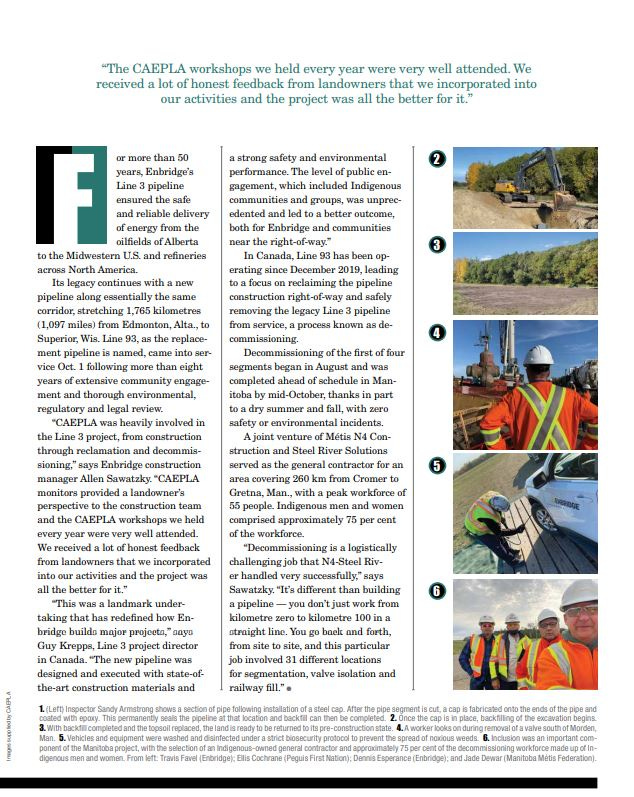First segment of Enbridge’s legacy Line 3 safely taken out of service
By David Coll
“The CAEPLA workshops we held every year were very well attended. We received a lot of honest feedback from landowners that we incorporated into our activities and the project was all the better for it.”
For more than 50 years, Enbridge’s Line 3 pipeline ensured the safe and reliable delivery of energy from the oilfields of Alberta to the Midwestern U.S. and refineries across North America.
Its legacy continues with a new pipeline along essentially the same corridor, stretching 1,765 kilometres (1,097 miles) from Edmonton, Alta., to Superior, Wis. Line 93, as the replacement pipeline is named, came into service Oct. 1 following more than eight years of extensive community engagement and thorough environmental, regulatory and legal review.
“CAEPLA was heavily involved in the Line 3 project, from construction through reclamation and decommissioning,” says Enbridge construction manager Allen Sawatzky. “CAEPLA monitors provided a landowner’s perspective to the construction team and the CAEPLA workshops we held every year were very well attended. We received a lot of honest feedback from landowners that we incorporated into our activities and the project was all the better for it.”
“This was a landmark undertaking that has redefined how Enbridge builds major projects,” says Guy Krepps, Line 3 project director in Canada. “The new pipeline was designed and executed with state-of-the-art construction materials and a strong safety and environmental performance. The level of public engagement, which included Indigenous communities and groups, was unprecedented and led to a better outcome, both for Enbridge and communities near the right-of-way.”
In Canada, Line 93 has been operating since December 2019, leading to a focus on reclaiming the pipeline construction right-of-way and safely removing the legacy Line 3 pipeline from service, a process known as decommissioning.
Decommissioning of the first of four segments began in August and was completed ahead of schedule in Manitoba by mid-October, thanks in part to a dry summer and fall, with zero safety or environmental incidents.
A joint venture of Métis N4 Construction and Steel River Solutions served as the general contractor for an area covering 260 km from Cromer to Gretna, Man., with a peak workforce of 55 people. Indigenous men and women comprised approximately 75 per cent of the workforce.
“Decommissioning is a logistically challenging job that N4-Steel River handled very successfully,” says Sawatzky. “It’s different than building a pipeline—you don’t just work from kilometre zero to kilometre 100 in a straight line. You go back-and-forth, from site to site, and this particular job involved 31 different locations for segmentation, valve isolation and railway fill.”
-
Inspector Sandy Armstrong shows a section of pipe following installation of a steel cap. After the pipe segment is cut, a cap is fabricated onto the ends of the pipe and coated with epoxy. This permanently seals the pipeline at that location and backfill can then be completed.
-
Once the cap is in place, backfilling of the excavation begins.
-
With backfill completed and the topsoil replaced, the land is ready to be returned to its pre-construction state.
-
A worker looks on during removal of a valve south of Morden, Man.
-
Vehicles and equipment were washed and disinfected under a strict biosecurity protocol to prevent the spread of noxious weeds.
-
Inclusion was an important component of the Manitoba project, with the selection of an Indigenous-owned general contractor and approximately 75 per cent of the decommissioning workforce made up of Indigenous men and women. From left: Travis Favel (Enbridge); Ellis Cochrane (Peguis First Nation); Dennis Esperance (Enbridge); and Jade Dewar (Manitoba Métis Federation).
Do you like this page?



